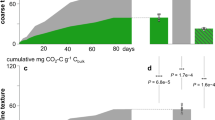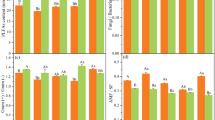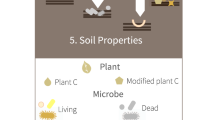Abstract
Many organic pollutants are readily degradable by microorganisms in soil, but the importance of soil organic matter for their transformation by specific microbial taxa is unknown. In this study, sorption and microbial degradation of phenol and 2,4-dichlorophenol (DCP) were characterized in three soil variants, generated by different long-term fertilization regimes. Compared with a non-fertilized control (NIL), a mineral-fertilized NPK variant showed 19% and a farmyard manure treated FYM variant 46% more soil organic carbon (SOC). Phenol sorption declined with overall increasing SOC because of altered affinities to the clay fraction (soil particles <2 mm in diameter). In contrast, DCP sorption correlated positively with particulate soil organic matter (present in the soil particle fractions of 63–2000 μm). Stable isotope probing identified Rhodococcus, Arthrobacter (both Actinobacteria) and Cryptococcus (Basidiomycota) as the main degraders of phenol. Rhodococcus and Cryptococcus were not affected by SOC, but the participation of Arthrobacter declined in NPK and even more in FYM. 14C-DCP was hardly metabolized in the NIL variant, more efficiently in FYM and most in NPK. In NPK, Burkholderia was the main degrader and in FYM Variovorax. This study demonstrates a strong effect of SOC on the partitioning of organic pollutants to soil particle size fractions and indicates the profound consequences that this process could have for the diversity of bacteria involved in their degradation.
Similar content being viewed by others
Log in or create a free account to read this content
Gain free access to this article, as well as selected content from this journal and more on nature.com
or
References
Ahmad R, Kookana RS, Alston AM, Skjemstad JO . (2001). The nature of soil organic matter affects sorption of pesticides. 1. Relationships with carbon chemistry as determined by 13C CPMAS NMR spectroscopy. Environ Sci Technol 35: 878–884.
Altermann M, Rinklebe J, Merbach I, Körschens M, Langer U, Hofmann B . (2005). Chernozem - soil of the year 2005. J Plant Nutr Soil Sc 168: 725–740.
Altschul SF, Gish W, Miller W, Myers EW, Lipman DJ . (1990). Basic local alignment serach tool. J Mol Biol 215: 403–410.
Amelung W, Zech W, Zhang X, Follett RF, Tiessen H, Knox E et al. (1998). Carbon, nitrogen, and sulfur pools in particle-size fractions as influenced by climate. Soil Sci Soc Am J 62: 172–181.
Ashelford KE, Chuzhanova NA, Fry JC, Jones AJ, Weightman AJ . (2005). At least 1 in 20 16S rRNA sequence records currently held in public repositories is estimated to contain substantial anomalies. Appl Environ Microbiol 71: 7724–7736.
Benoit P, Barriuso E, Soulas G . (1999). Degradation of 2,4-D, 2,4-dichlorophenol, and 4-chlorophenol in soil after sorption on humified and nonhumified organic matter. J Environ Qual 28: 1127–1135.
Bergauer P, Fonteyne PA, Nolard N, Schinner F, Margesin R . (2005). Biodegradation of phenol and phenol-related compounds by psychrophilic and cold-tolerant alpine yeasts. Chemosphere 59: 909–918.
Blair N, Faulkner RD, Till AR, Korschens M, Schulz E . (2006). Long-term management impacts on soil C, N and physical fertility - Part II: Bad Lauchstadt static and extreme FYM experiments. Soil Till Res 91: 39–47.
Böhme L, Böhme F . (2006). Soil microbiological and biochemical properties affected by plant growth and different long-term fertilisation. Eur J Soil Biol 42: 1–12.
Böhme L, Langer U, Böhme F . (2005). Microbial biomass, enzyme activities and microbial community structure in two European long-term field experiments. Agr Ecosyst Environ 109: 141–152.
Bosma TNP, Middeldorp PJM, Schraa G, Zehnder AJB . (1997). Mass transfer limitation of biotransformation: quantifying bioavailability. Environ SciTechnol 31: 248–252.
Cebron A, Louvel B, Faure P, France-Lanord C, Chen Y, Murrell JC et al. (2011). Root exudates modify bacterial diversity of phenanthrene degraders in PAH-polluted soil but not phenanthrene degradation rates. Environ Microbiol 13: 722–736.
Christensen BT . (1992). Physical fractionation of soil and organic matter in primary particle size and density separates. In: Stewart BA (ed). Advances in Soil Science. Springer Verlag: New York, pp 1–90.
Cole JR, Wang Q, Cardenas E, Fish J, Chai B, Farris RJ et al. (2009). The Ribosomal Database Project: improved alignments and new tools for rRNA analysis. Nucleic Acids Res 37: D141–D145.
Cupples AM, Sims GK . (2007). Identification of in situ 2,4-dichlorophenoxyacetic acid-degrading soil microorganisms using DNA-stable isotope probing. Soil Biol Biochem 39: 232–238.
Demyan MS, Rasche F, Schulz E, Breulmann M, Mueller T, Cadisch G . (2012). Use of specific peaks obtained by diffuse reflectance Fourier transform mid-infrared spectroscopy to study the composition of organic matter in a Haplic Chernozem. Eur J Soil Sci 63: 189–199.
DeRito CM, Madsen EL . (2009). Stable isotope probing reveals Trichosporon yeast to be active in situ in soil phenol metabolism. ISME J 3: 477–485.
Dohrmann AB, Tebbe CC . (2004). Microbial community analysis by PCR-single-strand conformation polymorphism (PCR-SSCP). In: Kowalchuk GA, de Bruijn F, Head IM, Akkermans ADL, van Elsas JD (eds). Molecular Microbial Ecology Manual. Kluwer Academic Publishers: Dordrecht, The Netherlands, pp 809–838.
Dohrmann AB, Tebbe CC . (2005). Effect of elevated tropospheric ozone on the structure of bacterial communities inhabiting the rhizosphere of herbaceous plants native to Germany. Appl Environ Microbiol 71: 7750–7758.
Farenhorst A . (2006). Importance of soil organic matter fractions in soil-landscape and regional assessments of pesticide sorption and leaching in soil. Soil Sci Soc Am J 70: 1005–1012.
Gardes M, Bruns TD . (1993). ITS primers with enhanced specificity for Basidiomycetes - Applications to the identification of mycorrhizae and rusts. Mol Ecol 2: 113–118.
Ghisalba O . (1983). Microbial degradation of chemical waste, an alternative to physical methiods of waste-disposal - chemical wastes and their biodegradation - an overview. Experientia 39: 1247–1257.
Guggenberger G, Christensen BT, Zech W . (1994). Land-use effects on the composition of organic matter in particle size separates of soil. 1. Lignin and carbohydrate signature. Eur J Soil Sci 45: 449–458.
Haggerty R, Gorelick SM . (1998). Modeling mass transfer processes in soil columns with pore-scale heterogeneity. Soil Sci Soc Am J 62: 62–74.
Haider K, Jagnow G, Kohnen R, Lim SU . (1974). Degradation of chlorinated benzenes, phenols and cyclohexane derivatives by benzene and phenol utilizing soil bacteria under aerobic conditions. Arch Microbiol 96: 183–200.
Hofrichter M, Bublitz F, Fritsche W . (1994). Unspecific degradation of halogenated phenols by the soil fungus Penicillium frequentans BI-7/2. J Basic Microbiol 34: 163–172.
Huang WL, Ping PA, Yu ZQ, Fu HM . (2003). Effects of organic matter heterogeneity on sorption and desorption of organic contaminants by soils and sediments. Appl Geochem 18: 955–972.
Jenkinson DS, Powlson DS . (1976). Effects of biocidal treatments on metabolism in soil. 5. Methods for measuring soil microbial biomass. Soil Biol Biochem 8: 209–213.
Karickhoff SW . (1981). Semiempirical estimation of sorption of hydrophobic pollutants on natural sediments and soils. Chemosphere 10: 833–846.
Karigar C, Mahesh A, Nagenahalli M, Yun DJ . (2006). Phenol degradation by immobilized cells of Arthrobacter citreus. Biodegradation 17: 47–55.
Kögel-Knabner I, Ekschmitt K, Flessa H, Guggenberger G, Matzner E, Marschner B et al. (2008). An integrative approach of organic matter stabilization in temperate soils: linking chemistry, physics, and biology. J Plant Nutr Soil Sc 171: 5–13.
Körschens M, Weigel A, Schulz E . (1998). Turnover of soil organic matter (SOM) and long-term balances - Tools for evaluating sustainable productivity of soils. Z Pflanz Bodenkunde 161: 409–424.
Leifeld J, Kögel-Knabner I . (2005). Soil organic matter fractions as early indicators for carbon stock changes under different land-use? Geoderma 124: 143–155.
Lillis L, Doyle E, Clipson N . (2009). Comparison of DNA- and RNA-based bacterial community structures in soil exposed to 2,4-dichlorophenol. J Appl Microbiol 107: 1883–1893.
Ludwig W, Strunk O, Westram R, Richter L, Meier H, Yadhukumar et al. (2004). ARB: a software environment for sequence data. Nucleic Acids Res 32: 1363–1371.
Mahmood S, Paton GI, Prosser JI . (2005). Cultivation-independent in situ molecular analysis of bacteria involved in degradation of pentachlorophenol in soil. Environ Microbiol 7: 1349–1360.
Margesin R, Fonteyne PA, Redl B . (2005). Low-temperature biodegradation of high amounts of phenol by Rhodococcus spp. and basidiomycetous yeasts. Res Microbiol 156: 68–75.
Martens R . (1985). Limitations of the application of the fumigation technique for biomass estimations in amended soils. Soil Biol Biochem 17: 57–63.
Martin F, Torelli S, Le Paslier D, Barbance A, Martin-Laurent F, Bru D et al. (2012). Betaproteobacteria dominance and diversity shifts in the bacterial community of a PAH-contaminated soil exposed to phenanthrene. Environ Pollut 162: 345–353.
Martin KJ, Rygiewicz PT . (2005). Fungal-specific PCR primers developed for analysis of the ITS region of environmental DNA extracts. BMC Microbiol 5: 28.
Martinkova L, Uhnakova B, Patek M, Nesvera J, Kren. V . (2009). Biodegradation potential of the genus Rhodococcus. Environ Int 35: 162–177.
Middelhoven WJ . (1993). Catabolism of benzene compounds by ascomycetous and basidiomycetous yeasts and yeast-like fungi - a literature review and expeirmental approach. A Van Leeuw J Microb 63: 125–144.
Neufeld JD, Vohra J, Dumont MG, Lueders T, Manefield M, Friedrich MW et al. (2007). DNA stable-isotope probing. Nat Protoc 2: 860–866.
Neumann D, Heuer A, Hemkemeyer M, Martens R, Tebbe CC . (2013). Response of microbial communities to long-term fertilization depends on their microhabitat. FEMS Microbiol Ecol 86: 71–84.
OECD (2000). Adsorption-desorption using a batch equilibrium method. Test 106. Organisation for Economic Co-Operation and Development (ed). OECD Guidelines for Testing of Chemicals Section 1: Physico-Chemical Properties. OECD: Paris.
Padmanabhan P, Padmanabhan S, DeRito C, Gray A, Gannon D, Snape JR et al. (2003). Respiration of 13C-labeled substrates added to soil in the field and subsequent 16S rRNA gene analysis of 13C-labeled soil DNA. Appl Environ Microbiol 69: 1614–1622.
Radajewski S, Ineson P, Parekh NR, Murrell JC . (2000). Stable-isotope probing as a tool in microbial ecology. Nature 403: 646–649.
Rapp P, Timmis KN . (1999). Degradation of chlorobenzenes at nanomolar concentrations by Burkholderia sp. strain PS14 in liquid cultures and in soil. Appl Environ Microbiol 65: 2547–2552.
Schulten HR, Leinweber P, Sorge C . (1993). Composition of organic matter in particle size fractions of an agricultural soil. J Soil Sci 44: 677–691.
Schwieger F, Tebbe CC . (1998). A new approach to utilize PCR-single-strand-conformation polymorphism for 16S rRNA gene-based microbial community analysis. Appl Environ Microbiol 64: 4870–4876.
Stamatakis AP, Ludwig T, Meier H . (2004). The AxML program family for maximum likelihood-based phylogenetic tree inference. Concurr Comp-Pract E 16: 975–988.
Tamura K, Dudley J, Nei M, Kumar S . (2007). MEGA4: molecular evolutionary genetics analysis (MEGA) software version 4.0. Mol Biol Evol 24: 1596–1599.
Tillmann S, Strompl C, Timmis KN, Abraham WR . (2005). Stable isotope probing reveals the dominant role of Burkholderia species in aerobic degradation of PCBs. FEMS Microbiol Ecol 52: 207–217.
Tulp HC, Fenner K, Schwarzenbach RP, Goss KU . (2009). pH-Dependent sorption of acidic organic chemicals to soil organic matter. Environ Sci Technol 43: 9189–9195.
Uhlik O, Wald J, Strejcek M, Musilova L, Ridl J, Hroudova M et al. (2012). Identification of bacteria utilizing biphenyl, benzoate, and naphthalene in long-term contaminated soil. PLoS One 7: e490653.
Uyttebroek M, Breugelmans P, Janssen M, Wattiau P, Joffe B, Karlson U et al. (2006). Distribution of the Mycobacterium community and polycyclic aromatic hydrocarbons (PAHs) among different size fractions of a long-term PAH-contaminated soil. Environ Microbiol 8: 836–847.
Vance ED, Brookes PC, Jenkinson DS . (1987). Microbial biomass measurements in forest soils - the use of chloroform fumigation incubation method in strongly acidic soils. Soil Biol Biochem 19: 697–702.
White TJ, Burns T, Lee S, Taylor JW . (1990). Analysis of phylogenetic relationship by amplification and direct sequencing of ribosomal RNA genes. In: Innis MA, Gelfand DH, Sninsky JJ, White TJ (eds). PCR Protocols: A Guide to Methods and Applications. Academic Press: San Diego, pp 315–322.
Wolf DC, Dao TH, Scott HD, Lavy TL . (1989). Influence of sterilization methods on selected soil microbiological, physical, and chemical properties. J Environ Qual 18: 39–44.
Wu SC, Gschwend PM . (1986). Sorption kinetics of hydrophobic organic compounds to natural sediments and soils. Environ Sci Technol 20: 717–725.
Xing BS, McGill WB, Dudas MJ, Maham Y, Hepler L . (1994). Sorption of phenol by selected biopolymers - Isotherms, energetics, and polarity. Environ Sci Technol 28: 466–473.
Xing BS, Pignatello JJ . (1996). Time-dependent isotherm shape of organic compounds in soil organic matter: implications for sorption mechanism. Environ Toxicol Chem 15: 1282–1288.
Xing BS, Pignatello JJ, Gigliotti B . (1996). Competitive sorption between atrazine and other organic compounds in soils and model sorbents. Environ Sci Technol 30: 2432–2440.
Acknowledgements
We thank Ines Merbach (UFZ, Experimental Station Bad Lauchstädt) and Kai Totsche (University of Jena) for supporting this work, Anja B Dohrmann for discussion, Denis Finke for help with the adsorption studies, and Karin Trescher and Katja Krause for excellent technical assistance. This study contributes to SPP1315 (Biogeochemical Interfaces in Soils), financially support by the German Research Foundation, DFG (project numbers Te383/3-1 and Te383/3-2).
Author information
Authors and Affiliations
Corresponding author
Ethics declarations
Competing interests
The authors declare no conflict of interest.
Additional information
Supplementary Information accompanies this paper on The ISME Journal website
Supplementary information
Rights and permissions
About this article
Cite this article
Neumann, D., Heuer, A., Hemkemeyer, M. et al. Importance of soil organic matter for the diversity of microorganisms involved in the degradation of organic pollutants. ISME J 8, 1289–1300 (2014). https://doi.org/10.1038/ismej.2013.233
Received:
Revised:
Accepted:
Published:
Issue date:
DOI: https://doi.org/10.1038/ismej.2013.233
Keywords
This article is cited by
-
Digital mapping of cultivated land soil organic matter in hill-mountain and plain regions
Journal of Soils and Sediments (2024)
-
Isolation and characterization of Rhizobium from non-leguminous potato plants: New frontiers in Rhizobium research
Biology and Fertility of Soils (2024)
-
Pesticide residues degradation strategies in soil and water: a review
International Journal of Environmental Science and Technology (2023)
-
Effects of Biochar Amendment on Nitrous Oxide Emission, Bacterial and Fungal Community Composition in a Tobacco-Planting Soil
Journal of Soil Science and Plant Nutrition (2023)
-
First report of diazotrophic Brevundimonas spp. as growth enhancer and root colonizer of potato
Scientific Reports (2020)



